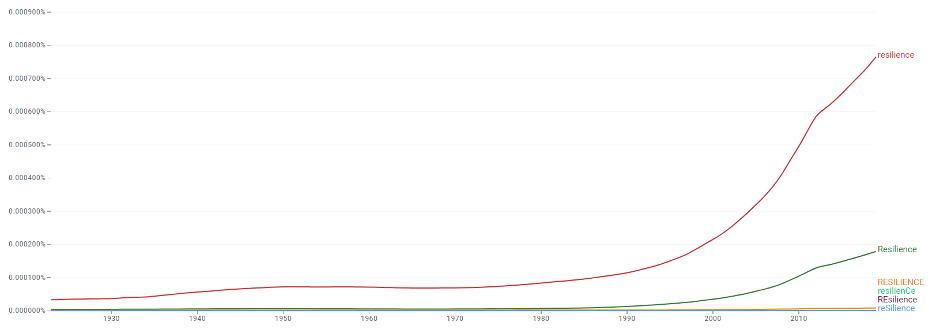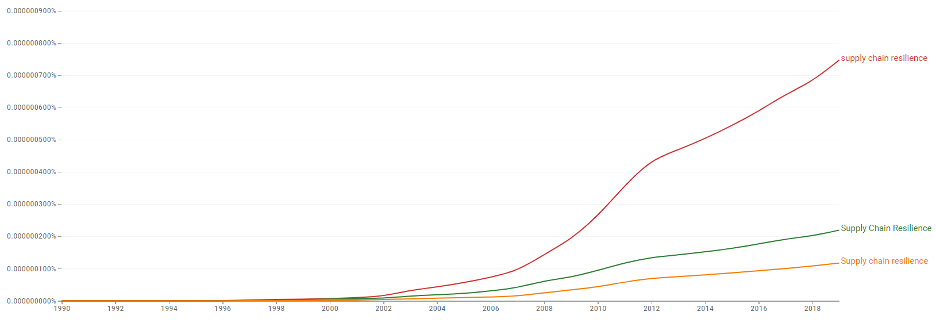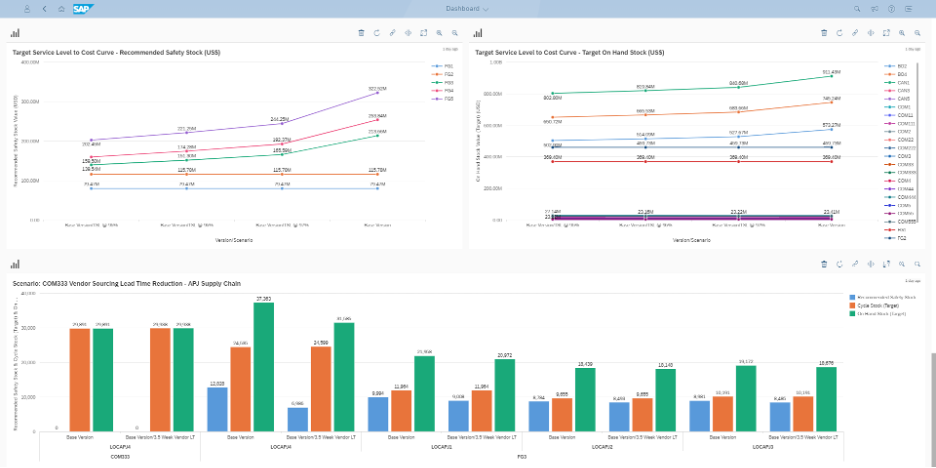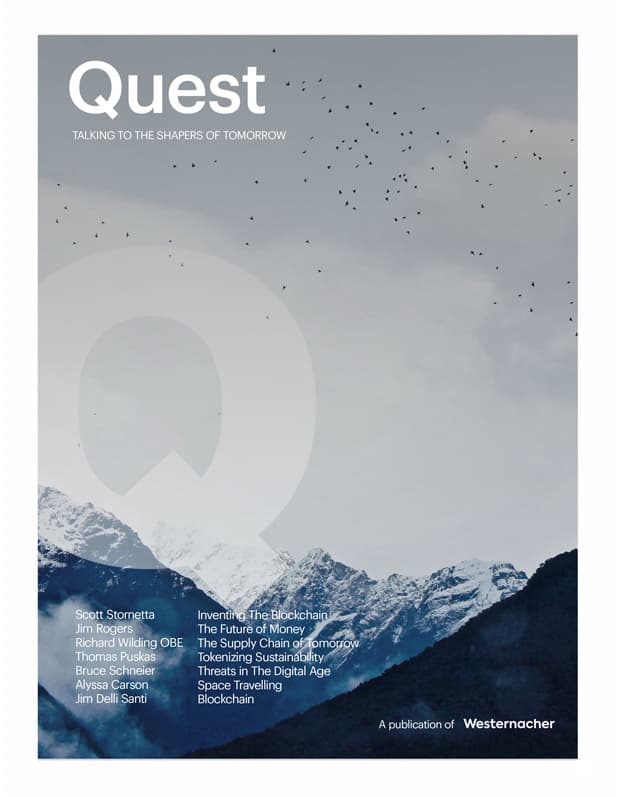Share this article
Follow us on Linkedin
Resilience is defined by “the capacity to withstand or to recover from difficulties” or “the ability of a substance or object to spring back into shape”, according to the Oxford Language dictionary.
In the last 100 hundred years, disruptive changes in the history of humanity could be the reason why the usage of the word resilience has increased dramatically, especially changes touching the very existence of nature, people, places, and, of course, businesses.

Trend Chart from 1923 to 2023 counting number of times Resilience is used.
(Source: Google Ngram Viewer, https://books.google.com/ngrams/graph?content=resilience&year_start=1923&year_end=2019&corpus=en-2019&smoothing=7&case_insensitive=true)
It is also not surprising that the phrase “supply chain resilience” has also increased in usage in the last 20 years. In addition to increased competitive pressures and offshoring manufacturing decisions derived from globalization, e-commerce technology has changed how we, as consumers, buy goods and services, leading to on-going changes in demand and consumer preferences.
Additionally, global sources of supply have been under multiple disruptions: a pandemic, geopolitical events like war and conflict, and climate change. When possible, businesses seek to replace supply dependencies on single sources with multiple sources of supply. Off-shoring practices of the past are converting to near-shoring ones to shorten supply lead times, inherited variability, and handle increasing freight costs. Droughts and floods may require more flexibility in securing multiple modes of transport.
The low water levels in the Panama Canal are a recent example of how climate change has the ability to impact supply chains. As we head into the holiday season, we should expect to see delivery delays across the United States. We recommend getting your holiday shopping done early in 2023!

Trend Chart from 1990 to 2019 counting number of times Supply Chain Resilience is used.
(Source: Google Ngram Viewer, https://books.google.com/ngrams/graph?content=supply+chain+resilience&year_start=1990&year_end=2019&corpus=en-2019&smoothing=7&case_insensitive=true)
So, how do businesses respond to such disruptions today and in the future?
Planning is the answer – it offers the opportunity to introduce resilience capabilities to prepare supply chains for more robust executions. Planning can go beyond the deterministic requirements of managing a supply chain in the short-, medium- and long-term. It is not sufficient to drive a robust sales and operations planning process, balancing demand and supply, or a disciplined demand forecasting process with relative improvements in accuracy or determine supply capacity to meet demand.
To withstand disruptions, it is fundamental to embed the probabilistic nature of internal and external variables in supply chain planning. For this, introducing scenarios during the supply planning processes creates the range of possibilities to prepare a supply chain to handle internal and external variables potentially disrupting its expected performance.
SAP Integrated Business Planning for supply chain (SAP IBP) offers capabilities for scenario planning to influence demand planning, inventory planning and the S&OP processes. The scenario planning capabilities include the following:
- Inventory Optimization Operator
- Statistical Forecasting
- S&OP Operator
- S&OP Forecast Consumption
For inventory planning, planners can model nearly twenty input variables through its stochastic multi-stage inventory optimization solution covering demand, transportation, production, vendor sourcing and inventory policy variables such as demand forecast, demand variability, customer service levels, supply lead time, supply lead time variability, and minimum and maximum safety inputs. Examples of scenarios based on multiple customer service levels determine trade-off between meeting customer service levels and inventory investments. Or examples of scenarios shortening vendor supply lead times determine potential reductions in inventory.

Upper Left-Hand Chart: Customer Service Level Target – Safety Stock Cost Curve Per Product
Upper Right-Hand Chart: Customer Service Level Target – On Hand Stock Cost Curve Per Product
Bottom Chart: Vendor Lead Time Reduction Per Material and Location – Safety Stock, Cycle Stock and On Hand Stock
Across SAP IBP planning user interfaces, such as Microsoft Excel IBP Add-in or Fiori application Planner Workspace, planners can create scenarios and compare results to baseline plans and determine the magnitude of potential disruptions, seize resources requirements, and choose best paths to avert a potential disruption.
For this, at Westernacher Consulting, we can help with a scenario design in the Balancing step of the S&OP process. This design supports the S&OP team to follow process steps that:
- identify the most relevant drivers of risks to the supply chain,
- create scenarios that determine impact of drivers of risks,
- choose the most plausible scenario options,
- assess impact of risks, and
- create proposal plans that mitigate risks and, as a result, introduce resiliency in the supply chain.
Identify Drivers for Scenarios
Produce Scenarios
Describe Possible Options
Assess Risk and Impact
Create Decision Proposal
In sum, planning with SAP IBP opens the opportunity to build supply chain resilience comprehensively across internal and external variables impacting your supply chain.
Let’s talk.
